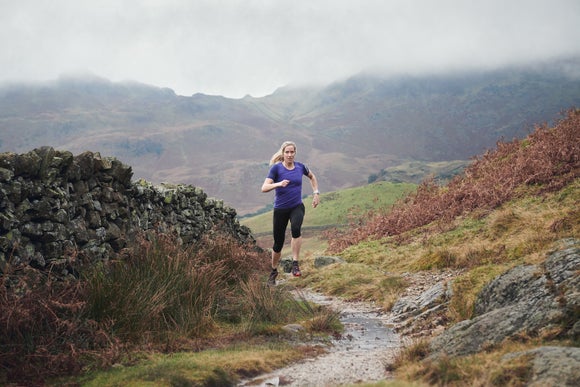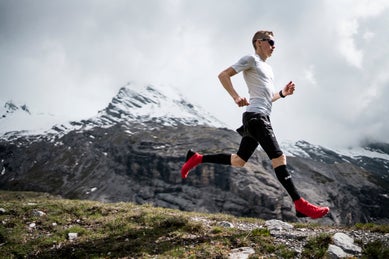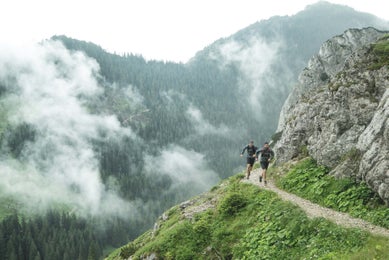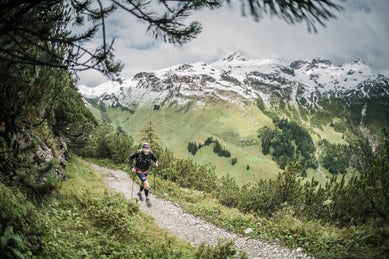Simple Tips for Trail Running in Any Weather
Brought To You By Salomon
Being properly prepared for your environment can make the difference between a miserable running experience and an enjoyable one. We've partnered with Salomon, one of the best trail running brands, to bring you the knowledge and gear you need for running in any type of weather.
-Published February 18, 2021

Spending extended periods of time running outdoors, especially on the trails, is certain to leave you exposed to the elements. Whether that means exposure to heat, cold, rain, snow, or any combination, being prepared can make a huge difference in staying safe and enjoying your run. And while we can't control the weather, we do have many tools at our disposal to make it less intimidating. So, in order to help get you ready for adverse weather conditions, we've partnered with experienced trail running company, Salomon, to put together some useful tips and tricks that any runner can implement to tackle the elements.
Running in the Heat
When running in hot conditions, staying hydrated is crucial. If you're not careful, you can easily become dehydrated or overexert yourself as your body has to work much harder to keep cool. Because carrying a big water bottle in your hand is probably not ideal for a long run, you should invest in a hydration pack or vest and plan to bring a little more water than you predict you'll need.
It's also important to monitor your effort while trail running in hot conditions. Instead of trying to maintain a set pace, run with a consistent effort level instead, which will help you better manage your energy so you can safely complete your run.
Finally, runners should make sure their clothes are designed to handle the heat as well. Breathable and moisture-wicking clothing (preferably lighter in colour) is engineered to help runners keep cool and is critical for runs in the heat. You should avoid cotton clothing, as it will absorb sweat and cause rubbing or chafing. Additionally, if you are on a high-elevation trail in the mountains, you may need extra sun protection. For this situation, we recommend using performance sunscreen or a hat and UV-blocking clothes.
Running in the Rain
If you decide to run in the rain, no matter how hard you try, you will never stay completely dry. And that's OK—embrace it. Running in the rain can be a lot of fun, but it also presents some unique challenges. Traction can be one of the biggest issues you'll face, and it requires shoes with large lugs to provide the proper grip to keep you on your feet. Additionally, finding a waterproof trail shoe can help keep your feet dry and lower the risk of things like blisters; but again, if you're out in the worst of conditions, wet socks and shoes may be unavoidable.
A waterproof jacket is another important piece of equipment for running in the rain. A jacket will not only help runners stay dry and avoid chafing, but it can be crucial if you are running in a cooler climate or higher elevation. Being wet and cold is a recipe for hypothermia, and runners need to ensure that they are prepared to avoid such dangers. In more temperate climates, lighter moisture-wicking and quick-drying clothing is an excellent option to help runners combat the rain.
Finally, runners who plan to trail run in the rain should leave a towel and a clean change of clothes in their car for after the run. No one likes wearing wet clothing, and it can be very uncomfortable on the drive home. So do yourself a favour and make sure you have some dry clothes to look forward to post-run.
Running in the Cold and Snow
It goes without saying that staying warm is the biggest focus when running in cold or snowy conditions, and dressing in layers to control your body temperature can make a big difference. Wearing clothing designed to secure heat while wicking away moisture is crucial for cold-weather trail runs. Depending on the temperature, runners should be prepared to wear a base layer, a mid-layer such as a fleece or long sleeve, and an outer layer like a windbreaker, rain jacket, or insulated jacket. These items will keep runners warm and also shield them from the elements.
Extra items like hats and gloves can further help runners combat cold conditions and can easily be stored in a running vest or pack. On a similar note, do not forget to bring hydration with you. You may not feel as hot and sweaty as you do when running in the heat, but you still require adequate hydration. Furthermore, packing extra clothing in the car for post-run comfort and warmth is an excellent way to finish a chilly trail run.
Finally, like running in the rain, traction can be problematic in snowy or icy conditions, so proper footwear is once again critical. Fortunately for runners, there are shoes designed specifically for these conditions. Salomon designs winter-specific shoes with gaiters and tungsten steel spikes that are excellent at gripping the trail in adverse conditions. If you do not have steel-spiked trail shoes, then at least ensure your footwear is equipped with aggressive lugs.





